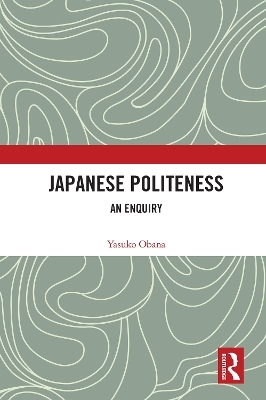
Japanese Politeness
Routledge (Verlag)
978-0-367-61225-2 (ISBN)
Although the Japanese language is one of the most quoted examples in politeness research, extant publications focus on particular areas of politeness, and very few of them enquire into the varied aspects of Japanese politeness. In this book, Yasuko Obana provides an integrated account of what signifies Japanese politeness.
By examining how far previous assumptions can apply to Japanese, Obana exposes a variety of characteristics of Japanese politeness. By taking a diachronic approach, she probes into what constitutes politeness, extracts key elements of the term ‘polite’ in Japanese, and demonstrates how modern honorifics’ apparent diverse, divergent uses and effects can be integrated into a systematic matrix. Furthermore, by quoting traditional Japanese language scholars’ (kokugo gakusha) studies, Obana brings different views into the open. She also carves out politeness strategies in Japanese that have not been adequately explored to date, and which often conform to the way in which honorifi cs behave because they refl ect social indexicality.
This book is a good reference for scholars in pragmatics, particularly for those who are working on politeness. It is useful for Japanese language teachers who want to know how to teach Japanese politeness to non-native learners. Postgraduate students of Japanese or pragmatics may also find this book useful for self-study.
Yasuko Obana is a Professor in the School of Science, Kwansei Gakuin University, Japan, teaching English to science students. She has published a number of articles in the fi eld of pragmatics, including politeness and anaphora in text processing. When she was teaching Japanese to university students in Australia, she was analysing learners’ errors in Japanese, which led her to publish Understanding Japanese: A Handbook for Learners and Teachers (Kurosio Publishers, Japan, 2000 ). She is now writing a co- authored book on Japanese pragmatics.
Contents
Preface: Some characteristics of this book
On a theory of politeness
Acknowledgements
Note on transcriptions
I. POLITENESS BEGINS
1. The Definition of Politeness: Review
1.0. Introduction
1.1. The etymology of ‘politeness’
1.2. Politeness as part of speech acts: A set of rules
1.3. Face-saving view: Brown and Levinson’s politeness theory
1.4. Discursive politeness
Endnote 1: Brown and Levinson’s positive and negative strategies
Endnote 2: Collectivism and individualism – Are they real?
2. The Underlying Meaning of Politeness: How it begins and evolves
2.1. The recent development of politeness studies: What ‘politeness’
constitutes
2.2. The underlying meaning of politeness: A diachronic approach
2.2.1. Involvement and independence as basic human needs/wants
2.2.2. Evaluations as the basis of politeness
2.3. Identity and role in Symbolic Interactionism
2.3.1. Symbolic Interactionism
2.3.2. Subcategories of Role-Identity and politeness
Endnote: ‘face’ ≠ ‘involvement & independence’
3. Politeness as a Social norm, and its Contingency and Discursiveness
3.1. The term ‘social norm’ in sociology
3.2. Politeness as a social norm and its contingencies
The summary of Part I
II. HONORIFICS
The Term ‘Polite’ in English and Japanese: Their conceptual differences
4.1. The etymology of term ‘polite’ in Japanese: Reigi tadashii and teineina
4.2. The sociological significance of ‘polite’ in English and Japanese
4.3. Keigo, keii hyoogen and politeness
The Origin of Honorifics: Distance begins
5.1. The origin of honorifics as taboo?
5.2. Norito as the origin of honorifics
5.2.1. The nature of norito
5.2.2. Honorifics in norito: A language for gods and goddesses
5.3. Characteristics of honorific use in norito
Understanding Honorifics
The classification of honorific styles
The status of honorifics in pragmatic principles
Honorifics as wakimae?
Honorifics as a positive or negative strategy?
Honorifics as ritual?
Honorifics as a social index and the linguistic evidence of a
social relationship
Socio-pragmatic functions of honorifics: Ideology, image and reality
6.3.1. From hierarchical to democratic ‘honorifics’?
6.3.2. How Japanese people in general perceive honorifics today
Endnote 1: Uchi as the extension of the speaker’s viewpoint to
differentiate honorific styles
Endnote 2: The uchi/soto distinction as Japanese mentality?
Endnote 3: The functions of the formula yoroshiku onegaishimasu
7. Variations and Derivations of Honorific Use
7.0. Introduction
7.1. Norms and contingencies: Bicchieri’s (2006) "grammar of society"
7.2. Speech level shifts: The case of plus-level shifts
7.2.1. Distance as a psychological barrier: Irony, sarcasm and conflict
7.2.2. The origin of honorifics: Gratitude, attentiveness, carefulness
7.2.3. Mock stage performance
7.2.4. Norms of honorifics, honorifics used in plus-level shifts and
the origin of honorifics: A pragmatic parallel
7.3. Other derivations of honorific use
7.3.1. Task-based role shifts
7.3.2. Women’s language
7.3.3. Personal styles
7.3.4. Absolute honorifics and self-exalting
Endnote: Examples of minus-level shifts
The summary of Part II
III. POLITENESS STRATEGIES
Strategies as the Implementation of One’s Role-Identity
The concept of Role-Identity
Role shifts and changes in politeness strategies
Direct and indirect requests: Role shifts
Repetition as assimilating with the other’s role: It takes two to complete it
Pretending to be a different person: Dissociative roles
Summary
Honorific Strategies
Pragmatic transfer as a source for distinguishing Japanese from English
Fundamental differences in strategic planning in English and Japanese: FTA based vs. Role-Identity based
Praising, recognition and checking: Evaluative statements are
condescending
Direct enquiries of the senior’s wants are intruding: The case of offer
Direct request: One’s entitlement prior to FTA consideration
The summary of Part III
IV. CONCLUDING REMARKS
What this book has offered
What constitutes politeness
Contingencies and discursiveness of politeness
Role-Identity as a process to determine polite behaviour
What this book has left out
References
Index
| Erscheinungsdatum | 13.07.2022 |
|---|---|
| Zusatzinfo | 4 Tables, black and white; 14 Line drawings, black and white; 14 Illustrations, black and white |
| Verlagsort | London |
| Sprache | englisch |
| Maße | 156 x 234 mm |
| Gewicht | 340 g |
| Themenwelt | Schulbuch / Wörterbuch ► Wörterbuch / Fremdsprachen |
| Geisteswissenschaften ► Sprach- / Literaturwissenschaft ► Sprachwissenschaft | |
| ISBN-10 | 0-367-61225-9 / 0367612259 |
| ISBN-13 | 978-0-367-61225-2 / 9780367612252 |
| Zustand | Neuware |
| Haben Sie eine Frage zum Produkt? |
aus dem Bereich


